文章目录
- 安装
- Elasticsearch 安装
- Kibana 安装
- Rest风格API
- 操作索引
- 基本概念
- 示例
- 创建索引
- 查看索引
- 删除索引
- 映射配置(不配置好像也行、智能判断)
- 新增数据
- 随机生成ID
- 自定义ID
- 修改数据
- 删除数据
- 查询
- 基本查询
- 查询所有(match_all)
- 匹配查询(match)
- 多字段查询(multi_match)
- 词条匹配(term)
- 多词条精确匹配(terms)
- 结果过滤
- 高级查询
- 过滤(filter)
- 排序
- 聚合aggregations
- 测试数据准备
- 聚合为桶
- 桶内度量
- 桶内嵌套桶
- 划分桶的其它方式
- 阶梯分桶Histogram Aggregation
- 范围分桶Range Aggregation
- 不同语言客户端代码
其实很早之前在大学学习Java的时候学习过ES,做日志存储用,不过后来在项目里面没被采用,很多年没用过逐渐淡忘了,如今工作需要用到,又得重新看一遍,还是简单再记一下流程及一些使用,方便以后查看~~
【Elasticsearch中文文档-简介】https://elasticsearch.bookhub.tech/set_up_elasticsearch/configuring_elasticsearch/
安装
Elasticsearch 安装
下载网址:https://www.elastic.co/cn/downloads

两个软件下载的版本最好相同
另外注意 Elasticsearch 的版本需要和你电脑上安装的JAVA JDK版本对应
像我电脑是是jdk1.8 对应es版本是7.6.1
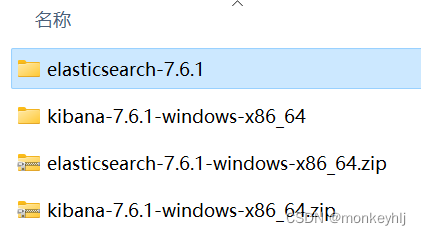
进入elasticsearch-7.6.1\bin,双击elasticsearch.bat即可运行,访问http://localhost:9200/,得到如下内容:
{
"name" : "HOULJ12",
"cluster_name" : "elasticsearch",
"cluster_uuid" : "hWbuydGRQLKKHia_KUVTjA",
"version" : {
"number" : "7.6.1",
"build_flavor" : "default",
"build_type" : "zip",
"build_hash" : "aa751e09be0a5072e8570670309b1f12348f023b",
"build_date" : "2020-02-29T00:15:25.529771Z",
"build_snapshot" : false,
"lucene_version" : "8.4.0",
"minimum_wire_compatibility_version" : "6.8.0",
"minimum_index_compatibility_version" : "6.0.0-beta1"
},
"tagline" : "You Know, for Search"
}
运行成功!
另外如果需要修改配置,基本上都在config文件夹下,可自行百度或看文档
Kibana 安装
进入kibana-7.6.1-windows-x86_64\bin,双击kibana.bat即可运行,访问http://localhost:5601/
【注】如果需要安装分词器,可参考文章尾部参考文章中有提到
Rest风格API
文档地址:https://www.elastic.co/guide/en/elasticsearch/reference/current/index.html
操作索引
基本概念
Elasticsearch也是基于Lucene的全文检索库,本质也是存储数据,很多概念与MySQL类似的,对应关系如下:
索引(indices)--------------------------------Databases 数据库
类型(type)---------------------------------Table 数据表
文档(Document)--------------------------Row 行
字段(Field)---------------------------Columns 列
示例
创建索引
Elasticsearch采用Rest风格API,因此其API就是一次http请求,你可以用任何工具发起http请求
创建索引的请求格式:
请求方式:PUT
请求路径:/索引库名
请求参数:json格式
PUT /索引库名

查看索引
GET /索引库名

可以用*来查看所有的索引库名:

kibana中也可以查看到:
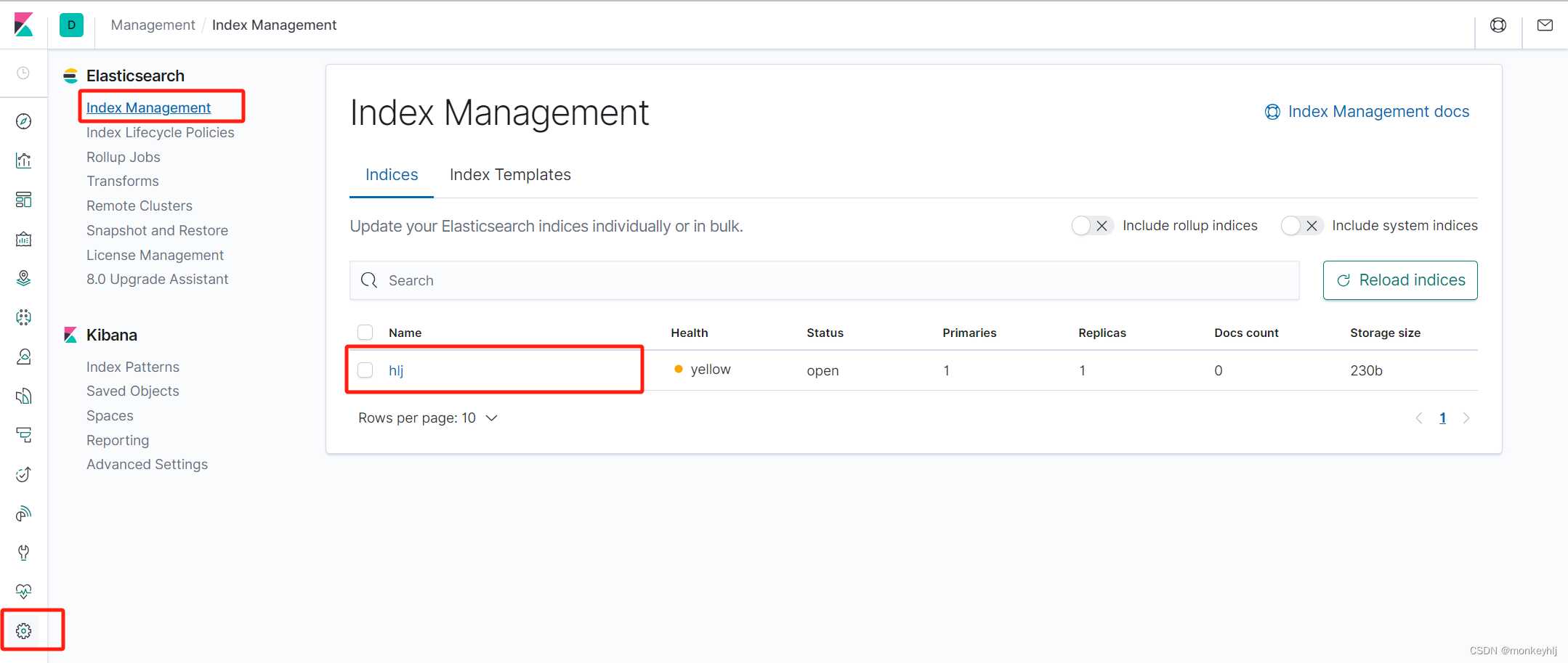
删除索引
DELETE /索引库名

映射配置(不配置好像也行、智能判断)
创建映射字段
PUT /索引库名/_mapping/类型名称
{
"properties": {
"字段名": {
"type": "类型",
"index": true,
"store": true,
"analyzer": "分词器"
}
}
}
类型名称:就是前面将的type的概念,类似于数据库中的不同表字段名:任意填写 ,可以指定许多属性,例如:type:类型,可以是text、long、short、date、integer、object等index:是否索引,默认为truestore:是否存储,默认为falseanalyzer:分词器,这里的ik_max_word即使用ik分词器
示例:
PUT bysl/_mapping/goods
{
"properties": {
"title": {
"type": "text",
"analyzer": "ik_max_word"
},
"images": {
"type": "keyword",
"index": "false"
},
"price": {
"type": "float"
}
}
}
【参考】字段类型:https://www.elastic.co/guide/en/elasticsearch/reference/current/mapping-types.html
响应结果:
{
"acknowledged": true
}
查看映射关系
GET /索引库名/_mapping
新增数据
随机生成ID
通过POST请求,可以向一个已经存在的索引库中添加数据
POST /索引库名/类型名
{
"key1":"value1",
"key2":"value2"
}
示例:
POST /test/goods/
{
"title":"小米手机",
"images":"http://image.bysl.com/12479122.jpg",
"price":2699.00
}

查看数据:
GET test/_search
{
"query":{
"match_all":{}
}
}
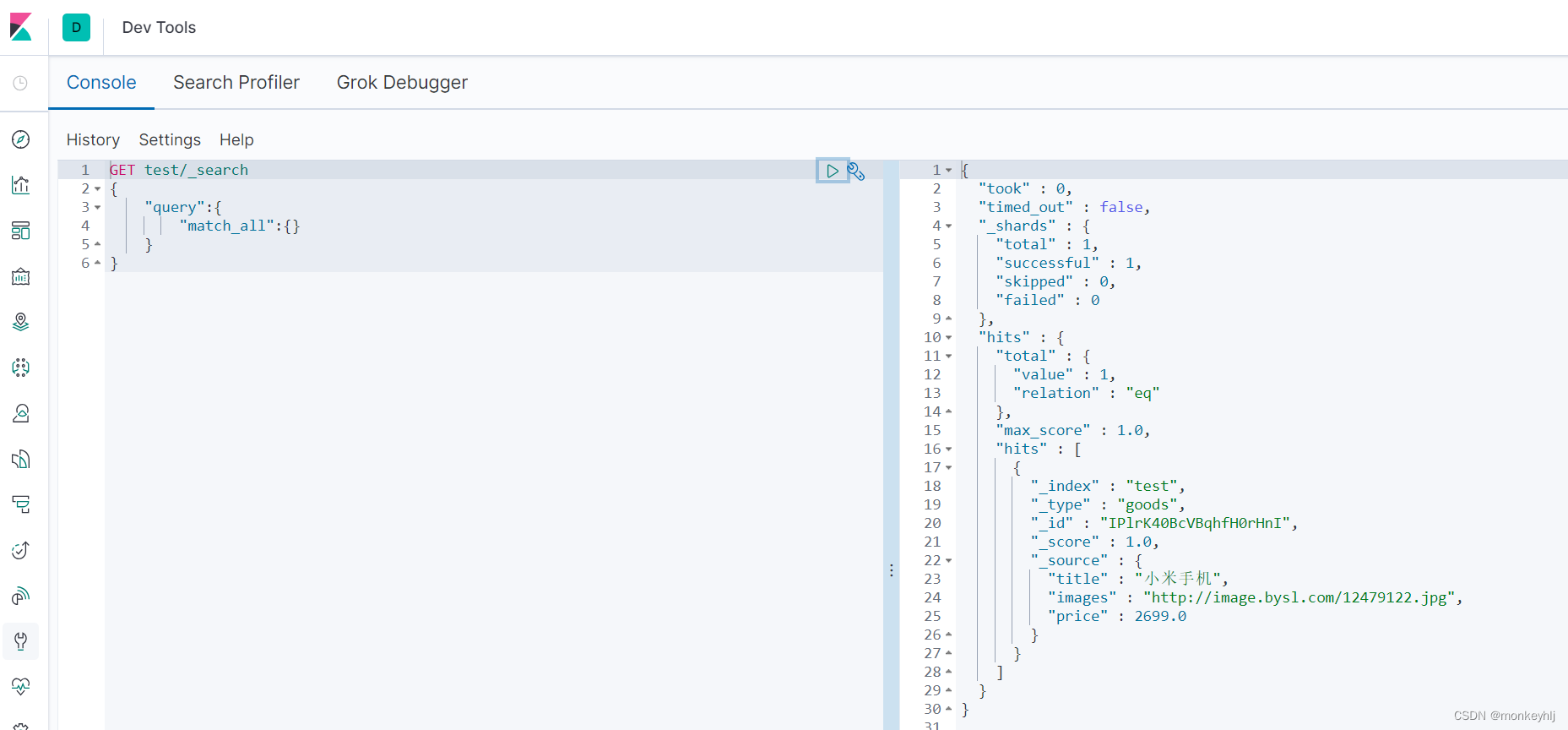
_source:源文档信息,所有的数据都在里面。
_id:这条文档的唯一标示,与文档自己的id字段没有关联
自定义ID
POST /索引库名/类型/ID值
{
"key1":"value1",
"key2":"value2"
}


修改数据
把刚才新增的请求方式改为PUT,就是修改了。不过修改必须指定id:
- id对应文档存在,则修改
- id对应文档不存在,则新增
PUT /test/goods/IPlrK40BcVBqhfH0rHnI
{
"title":"小米手机",
"images":"http://image.bysl.com/12479122.jpg",
"price":2688.00
}

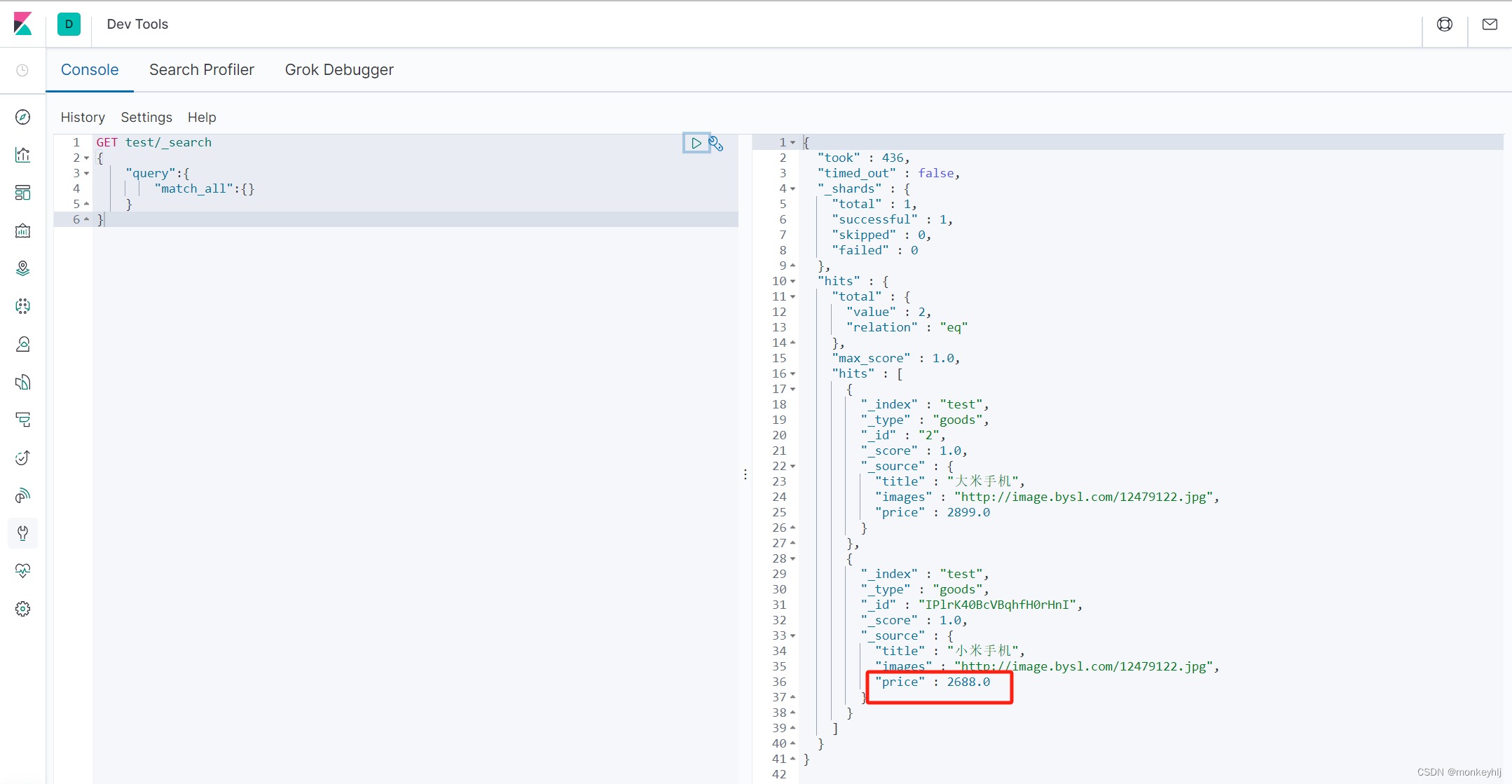
删除数据
删除使用DELETE请求,同样,需要根据id进行删除:
DELETE /索引库名/类型名/ID值

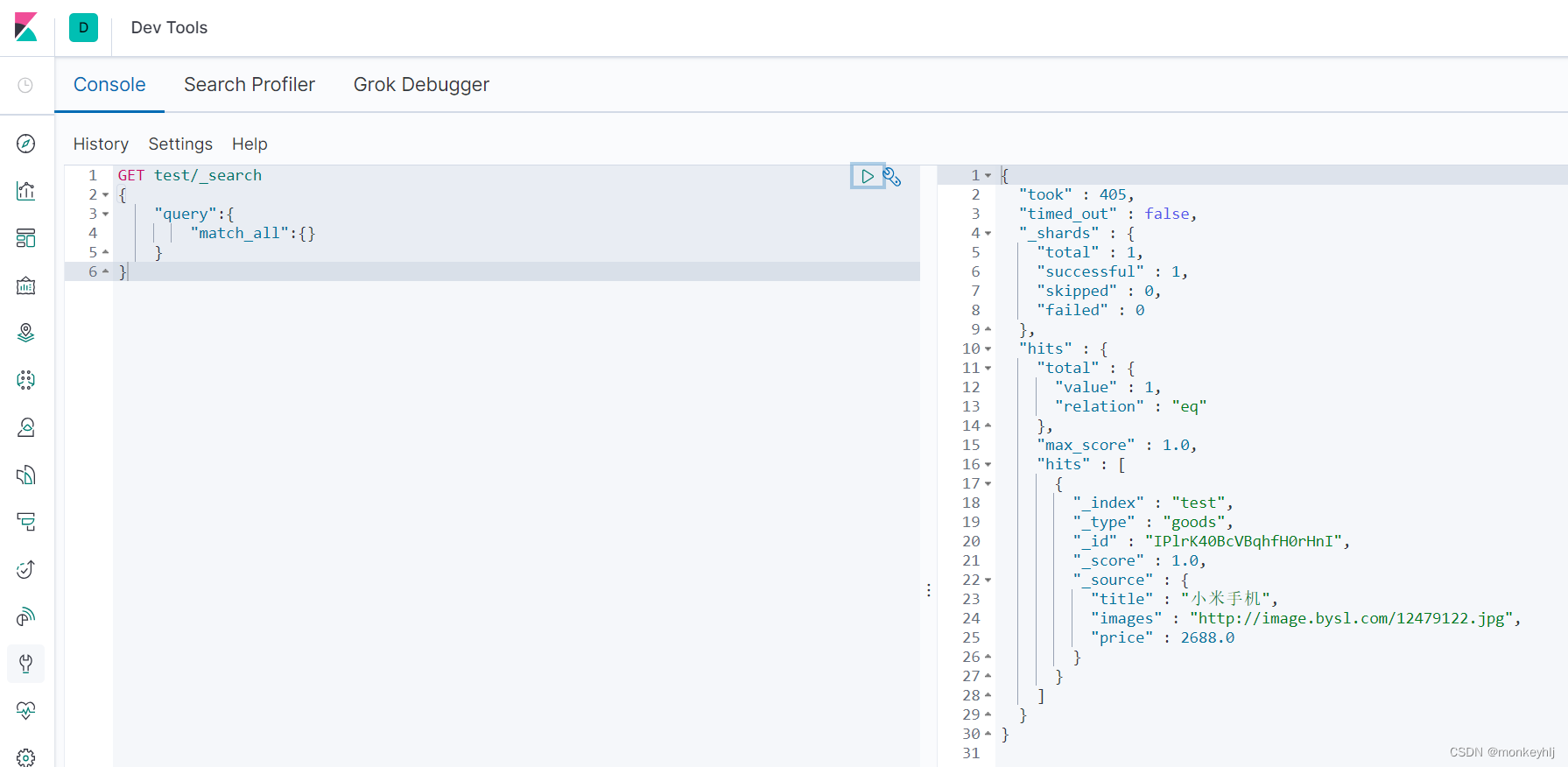
查询
基本查询
GET /索引库名/_search
{
"query":{
"查询类型":{
"查询条件":"查询条件值"
}
}
}
这里的query代表一个查询对象,里面可以有不同的查询属性
- 查询类型:
- 例如:
match_all,match,term,range等等
- 例如:
- 查询条件:查询条件会根据类型的不同,写法也有差异,后面详细讲解
查询所有(match_all)
GET /test/_search
{
"query":{
"match_all": {}
}
}
查询结果:
{
"took" : 774,
"timed_out" : false,
"_shards" : {
"total" : 1,
"successful" : 1,
"skipped" : 0,
"failed" : 0
},
"hits" : {
"total" : {
"value" : 3,
"relation" : "eq"
},
"max_score" : 1.0,
"hits" : [
{
"_index" : "test",
"_type" : "goods",
"_id" : "IPlrK40BcVBqhfH0rHnI",
"_score" : 1.0,
"_source" : {
"title" : "小米手机",
"images" : "http://image.bysl.com/12479122.jpg",
"price" : 2688.0
}
},
{
"_index" : "test",
"_type" : "goods",
"_id" : "2",
"_score" : 1.0,
"_source" : {
"title" : "小米手机222222",
"images" : "http://image.bysl.com/133.jpg",
"price" : 3999.0
}
},
{
"_index" : "test",
"_type" : "goods",
"_id" : "3",
"_score" : 1.0,
"_source" : {
"title" : "联想小新",
"images" : "http://image.bysl.com/17777.jpg",
"price" : 6999.0
}
}
]
}
}
took:查询花费时间,单位是毫秒time_out:是否超时_shards:分片信息hits:搜索结果总览对象total:搜索到的总条数max_score:所有结果中文档得分的最高分hits:搜索结果的文档对象数组,每个元素是一条搜索到的文档信息_index:索引库_type:文档类型_id:文档id_score:文档得分_source:文档的源数据
匹配查询(match)
or关系
match类型查询,会把查询条件进行分词,然后进行查询,多个词条之间是or的关系
GET /test/_search
{
"query":{
"match":{
"title":"联想"
}
}
}
搜索结果:
{
"took" : 12,
"timed_out" : false,
"_shards" : {
"total" : 1,
"successful" : 1,
"skipped" : 0,
"failed" : 0
},
"hits" : {
"total" : {
"value" : 1,
"relation" : "eq"
},
"max_score" : 2.0253944,
"hits" : [
{
"_index" : "test",
"_type" : "goods",
"_id" : "3",
"_score" : 2.0253944,
"_source" : {
"title" : "联想小新",
"images" : "http://image.bysl.com/17777.jpg",
"price" : 6999.0
}
}
]
}
}
在上面的案例中,多个词之间是or的关系:如果我输入联想小米,则包含联想或小米的都会查出来:

and关系
某些情况下,我们需要更精确查找,我们希望这个关系变成and,可以这样做:
GET /test/_search
{
"query":{
"match": {
"title": {
"query": "手机小米",
"operator": "and"
}
}
}
}
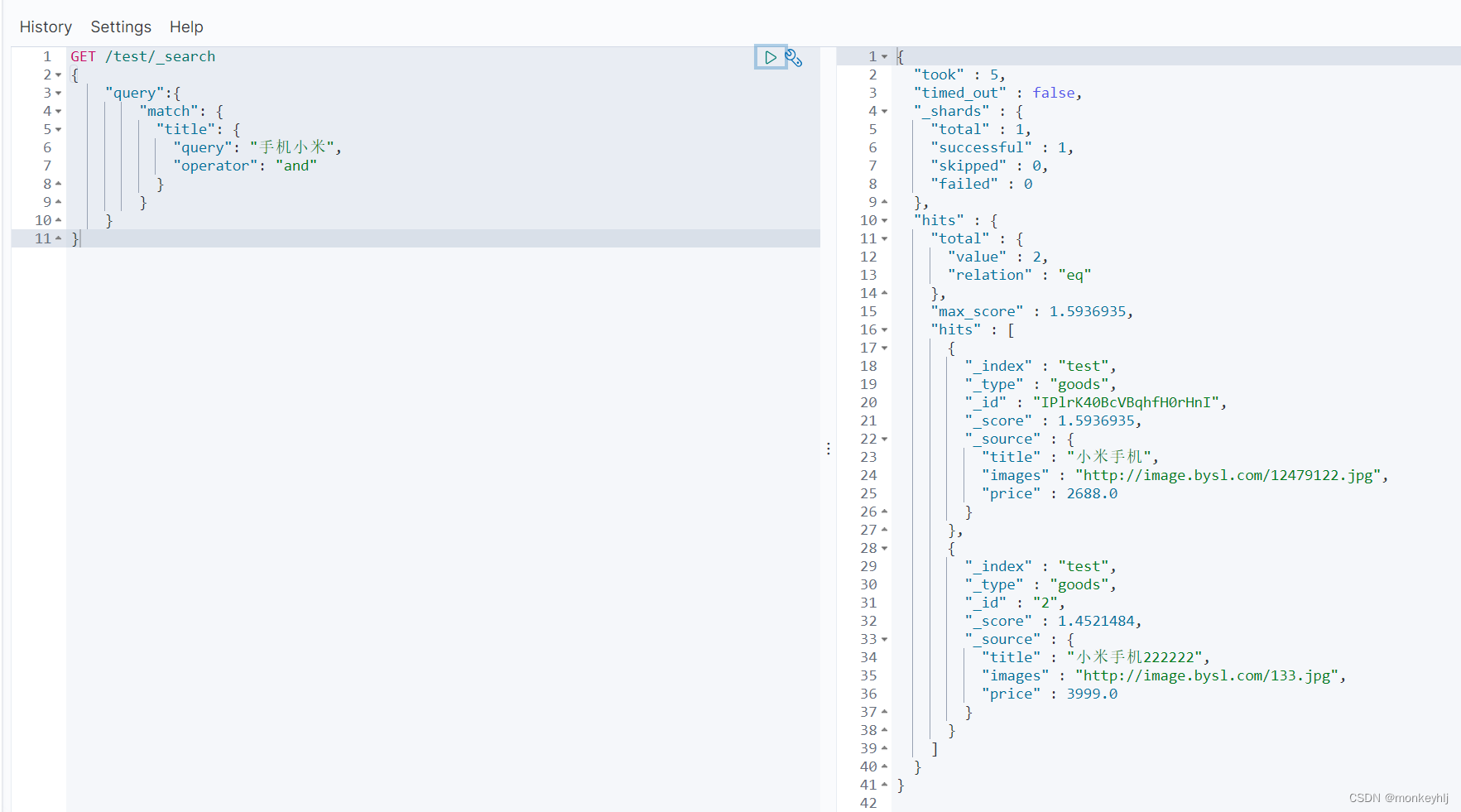
本例中,只有同时包含小米和手机的词条才会被搜索到
or和and之间?
在 or 与 and 间二选一有点过于非黑即白。 如果用户给定的条件分词后有 5 个查询词项,想查找只包含其中 4 个词的文档,该如何处理?将 operator 操作符参数设置成 and 只会将此文档排除。
有时候这正是我们期望的,但在全文搜索的大多数应用场景下,我们既想包含那些可能相关的文档,同时又排除那些不太相关的。换句话说,我们想要处于中间某种结果。
match 查询支持 minimum_should_match 最小匹配参数, 这让我们可以指定必须匹配的词项数用来表示一个文档是否相关。我们可以将其设置为某个具体数字,更常用的做法是将其设置为一个百分数,因为我们无法控制用户搜索时输入的单词数量:
GET /test/_search
{
"query":{
"match":{
"title":{
"query":"小米曲面电视",
"minimum_should_match": "75%"
}
}
}
}
本例中,搜索语句可以分为3个词,如果使用and关系,需要同时满足3个词才会被搜索到。这里我们采用最小品牌数:75%,那么也就是说只要匹配到总词条数量的75%即可,这里3*75% 约等于2。所以只要包含2个词条就算满足条件了
多字段查询(multi_match)
multi_match与match类似,不同的是它可以在多个字段中查询
GET /test/_search
{
"query":{
"multi_match": {
"query": "小米",
"fields": [ "title", "images" ]
}
}
}
词条匹配(term)
term 查询被用于精确值 匹配,这些精确值可能是数字、时间、布尔或者那些未分词的字符串
GET /test/_search
{
"query":{
"term":{
"price":2699.00
}
}
}
多词条精确匹配(terms)
GET /test/_search
{
"query":{
"terms":{
"price":[2699.00,2899.00,3899.00]
}
}
}
结果过滤
直接指定字段_source
默认情况下,elasticsearch在搜索的结果中,会把文档中保存在_source的所有字段都返回。
如果我们只想获取其中的部分字段,我们可以添加_source的过滤
GET /test/_search
{
"_source": ["title","price"],
"query": {
"term": {
"price": 2688
}
}
}
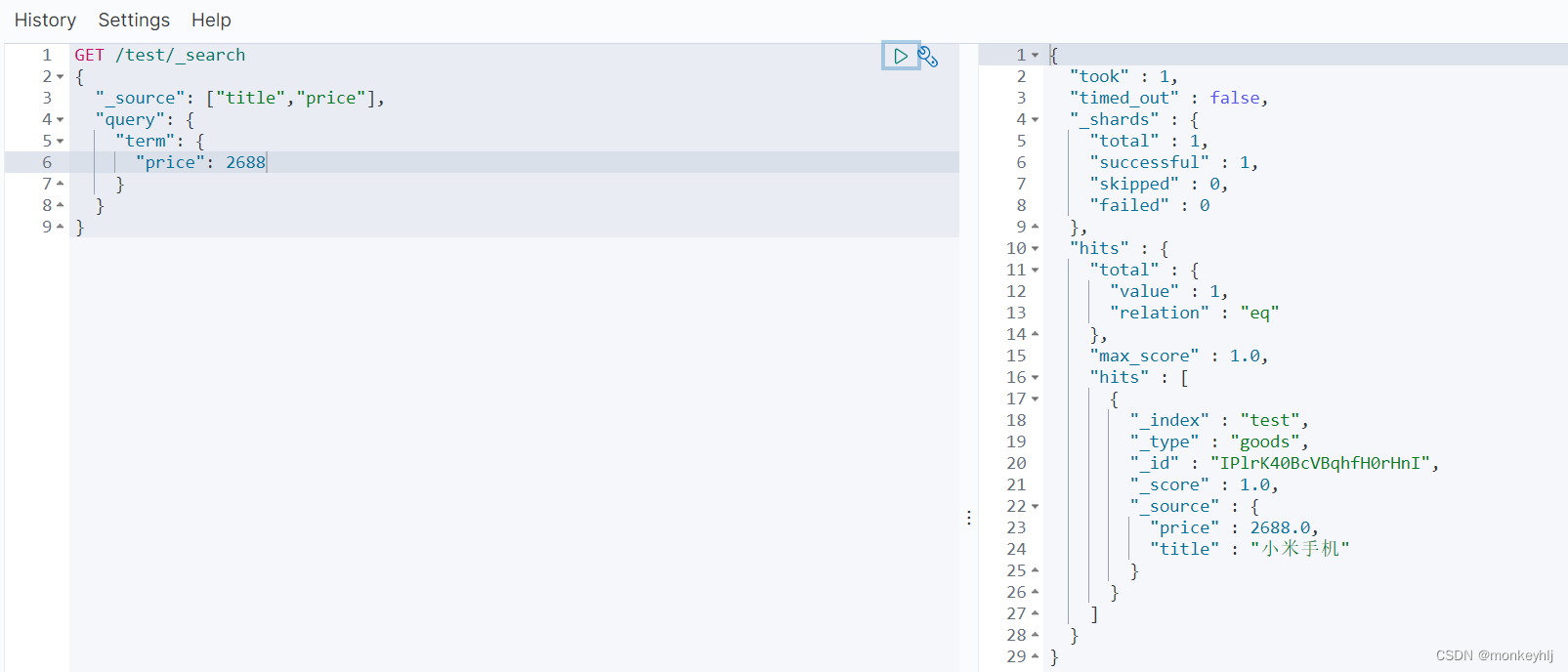
指定includes和excludes
includes:来指定想要显示的字段excludes:来指定不想要显示的字段
GET /test/_search
{
"_source": {
"includes":["title","price"]
},
"query": {
"term": {
"price": 2688
}
}
}
高级查询
布尔组合(bool)
bool把各种其它查询通过must(与)、must_not(非)、should(或)的方式进行组合
GET /test/_search
{
"query":{
"bool":{
"must": { "match": { "title": "大米" }},
"must_not": { "match": { "title": "电视" }},
"should": { "match": { "title": "手机" }}
}
}
}
范围查询(range)
range 查询找出那些落在指定区间内的数字或者时间
GET /test/_search
{
"query":{
"range": {
"price": {
"gte": 1000.0,
"lt": 2800.00
}
}
}
}
range查询允许以下字符:
| 操作符 | 说明 |
|---|---|
| gt | 大于 |
| gte | 大于等于 |
| lt | 小于 |
| lte | 小于等于 |
模糊查询(fuzzy)
fuzzy 查询是 term 查询的模糊等价。它允许用户搜索词条与实际词条的拼写出现偏差,但是偏差的编辑距离不得超过2:
GET /test/_search
{
"query": {
"fuzzy": {
"title": "米"
}
}
}
可以通过fuzziness来指定允许的编辑距离:
GET /test/_search
{
"query": {
"fuzzy": {
"title": {
"value":"米",
"fuzziness":1
}
}
}
}
过滤(filter)
所有的查询都会影响到文档的评分及排名。如果我们需要在查询结果中进行过滤,并且不希望过滤条件影响评分,那么就不要把过滤条件作为查询条件来用。而是使用filter方式:
GET /test/_search
{
"query":{
"bool":{
"must":{ "match": { "title": "小米手机" }},
"filter":{
"range":{"price":{"gt":2000.00,"lt":3800.00}}
}
}
}
}
【注意】filter中还可以再次进行bool组合条件过滤!
如果一次查询只有过滤,没有查询条件,不希望进行评分,我们可以使用constant_score取代只有 filter 语句的 bool 查询。在性能上是完全相同的,但对于提高查询简洁性和清晰度有很大帮助
GET /test/_search
{
"query":{
"constant_score": {
"filter": {
"range":{"price":{"gt":2000.00,"lt":3000.00}}
}
}
}
排序
单字段排序
sort 可以让我们按照不同的字段进行排序,并且通过order指定排序的方式
GET /test/_search
{
"query": {
"match": {
"title": "小米手机"
}
},
"sort": [
{
"price": {
"order": "desc"
}
}
]
}
多字段排序
假定我们想要结合使用 price和 _score(得分,假设有) 进行查询,并且匹配的结果首先按照价格排序,然后按照相关性得分排序:
GET /goods/_search
{
"query":{
"bool":{
"must":{ "match": { "title": "小米手机" }},
"filter":{
"range":{"price":{"gt":200000,"lt":300000}}
}
}
},
"sort": [
{ "price": { "order": "desc" }},
{ "_score": { "order": "desc" }}
]
}
聚合aggregations
测试数据准备
创建索引:
PUT /cars
存入数据:
POST /cars/transactions/_bulk
{ "index": {}}
{ "price" : 10000, "color" : "red", "make" : "honda", "sold" : "2014-10-28" }
{ "index": {}}
{ "price" : 20000, "color" : "red", "make" : "honda", "sold" : "2014-11-05" }
{ "index": {}}
{ "price" : 30000, "color" : "green", "make" : "ford", "sold" : "2014-05-18" }
{ "index": {}}
{ "price" : 15000, "color" : "blue", "make" : "toyota", "sold" : "2014-07-02" }
{ "index": {}}
{ "price" : 12000, "color" : "green", "make" : "toyota", "sold" : "2014-08-19" }
{ "index": {}}
{ "price" : 20000, "color" : "red", "make" : "honda", "sold" : "2014-11-05" }
{ "index": {}}
{ "price" : 80000, "color" : "red", "make" : "bmw", "sold" : "2014-01-01" }
{ "index": {}}
{ "price" : 25000, "color" : "blue", "make" : "ford", "sold" : "2014-02-12" }
聚合为桶
GET /cars/_search
{
"size" : 0,
"aggs" : {
"popular_colors" : {
"terms" : {
"field" : "color.keyword"
}
}
}
}
size: 查询条数,这里设置为0,因为我们不关心搜索到的数据,只关心聚合结果,提高效率aggs:声明这是一个聚合查询,是aggregations的缩写popular_colors:给这次聚合起一个名字,任意。terms:划分桶的方式,这里是根据词条划分field:划分桶的字段
结果:
{
"took" : 7,
"timed_out" : false,
"_shards" : {
"total" : 1,
"successful" : 1,
"skipped" : 0,
"failed" : 0
},
"hits" : {
"total" : {
"value" : 8,
"relation" : "eq"
},
"max_score" : null,
"hits" : [ ]
},
"aggregations" : {
"popular_colors" : {
"doc_count_error_upper_bound" : 0,
"sum_other_doc_count" : 0,
"buckets" : [
{
"key" : "red",
"doc_count" : 4
},
{
"key" : "blue",
"doc_count" : 2
},
{
"key" : "green",
"doc_count" : 2
}
]
}
}
}
hits:查询结果为空,因为我们设置了size为0aggregations:聚合的结果popular_colors:我们定义的聚合名称buckets:查找到的桶,每个不同的color字段值都会形成一个桶key:这个桶对应的color字段的值doc_count:这个桶中的文档数量
桶内度量
GET /cars/_search
{
"size" : 0,
"aggs" : {
"popular_colors" : {
"terms" : {
"field" : "color.keyword"
},
"aggs":{
"avg_price": {
"avg": {
"field": "price"
}
}
}
}
}
}
aggs:我们在上一个aggs(popular_colors)中添加新的aggs。可见度量也是一个聚合avg_price:聚合的名称avg:度量的类型,这里是求平均值field:度量运算的字段
结果:
{
"took" : 2,
"timed_out" : false,
"_shards" : {
"total" : 1,
"successful" : 1,
"skipped" : 0,
"failed" : 0
},
"hits" : {
"total" : {
"value" : 8,
"relation" : "eq"
},
"max_score" : null,
"hits" : [ ]
},
"aggregations" : {
"popular_colors" : {
"doc_count_error_upper_bound" : 0,
"sum_other_doc_count" : 0,
"buckets" : [
{
"key" : "red",
"doc_count" : 4,
"avg_price" : {
"value" : 32500.0
}
},
{
"key" : "blue",
"doc_count" : 2,
"avg_price" : {
"value" : 20000.0
}
},
{
"key" : "green",
"doc_count" : 2,
"avg_price" : {
"value" : 21000.0
}
}
]
}
}
}
桶内嵌套桶
GET /cars/_search
{
"size" : 0,
"aggs" : {
"popular_colors" : {
"terms" : {
"field" : "color.keyword"
},
"aggs":{
"avg_price": {
"avg": {
"field": "price"
}
},
"maker":{
"terms":{
"field":"make.keyword"
}
}
}
}
}
}
- 原来的color桶和avg计算我们不变
maker:在嵌套的aggs下新添一个桶,叫做makerterms:桶的划分类型依然是词条filed:这里根据make字段进行划分
结果:
{
"took" : 2,
"timed_out" : false,
"_shards" : {
"total" : 1,
"successful" : 1,
"skipped" : 0,
"failed" : 0
},
"hits" : {
"total" : {
"value" : 8,
"relation" : "eq"
},
"max_score" : null,
"hits" : [ ]
},
"aggregations" : {
"popular_colors" : {
"doc_count_error_upper_bound" : 0,
"sum_other_doc_count" : 0,
"buckets" : [
{
"key" : "red",
"doc_count" : 4,
"maker" : {
"doc_count_error_upper_bound" : 0,
"sum_other_doc_count" : 0,
"buckets" : [
{
"key" : "honda",
"doc_count" : 3
},
{
"key" : "bmw",
"doc_count" : 1
}
]
},
"avg_price" : {
"value" : 32500.0
}
},
{
"key" : "blue",
"doc_count" : 2,
"maker" : {
"doc_count_error_upper_bound" : 0,
"sum_other_doc_count" : 0,
"buckets" : [
{
"key" : "ford",
"doc_count" : 1
},
{
"key" : "toyota",
"doc_count" : 1
}
]
},
"avg_price" : {
"value" : 20000.0
}
},
{
"key" : "green",
"doc_count" : 2,
"maker" : {
"doc_count_error_upper_bound" : 0,
"sum_other_doc_count" : 0,
"buckets" : [
{
"key" : "ford",
"doc_count" : 1
},
{
"key" : "toyota",
"doc_count" : 1
}
]
},
"avg_price" : {
"value" : 21000.0
}
}
]
}
}
}
- 我们可以看到,新的聚合
maker被嵌套在原来每一个color的桶中。 - 每个颜色下面都根据
make字段进行了分组 - 我们能读取到的信息:
- 红色车共有4辆
- 红色车的平均售价是 32500 美元。
- 其中3辆是 Honda 本田制造,1辆是 BMW 宝马制造。
划分桶的其它方式
划分桶的方式有很多,例如:
Date Histogram Aggregation:根据日期阶梯分组,例如给定阶梯为周,会自动每周分为一组Histogram Aggregation:根据数值阶梯分组,与日期类似Terms Aggregation:根据词条内容分组,词条内容完全匹配的为一组Range Aggregation:数值和日期的范围分组,指定开始和结束,然后按段分组
刚刚的案例中,我们采用的是Terms Aggregation,即根据词条划分桶
阶梯分桶Histogram Aggregation
比如,我们对汽车的价格进行分组,指定间隔interval为5000:
GET /cars/_search
{
"size":0,
"aggs":{
"price":{
"histogram": {
"field": "price",
"interval": 5000
}
}
}
}
结果:
{
"took" : 7,
"timed_out" : false,
"_shards" : {
"total" : 1,
"successful" : 1,
"skipped" : 0,
"failed" : 0
},
"hits" : {
"total" : {
"value" : 8,
"relation" : "eq"
},
"max_score" : null,
"hits" : [ ]
},
"aggregations" : {
"price" : {
"buckets" : [
{
"key" : 10000.0,
"doc_count" : 2
},
{
"key" : 15000.0,
"doc_count" : 1
},
{
"key" : 20000.0,
"doc_count" : 2
},
{
"key" : 25000.0,
"doc_count" : 1
},
{
"key" : 30000.0,
"doc_count" : 1
},
{
"key" : 35000.0,
"doc_count" : 0
},
{
"key" : 40000.0,
"doc_count" : 0
},
{
"key" : 45000.0,
"doc_count" : 0
},
{
"key" : 50000.0,
"doc_count" : 0
},
{
"key" : 55000.0,
"doc_count" : 0
},
{
"key" : 60000.0,
"doc_count" : 0
},
{
"key" : 65000.0,
"doc_count" : 0
},
{
"key" : 70000.0,
"doc_count" : 0
},
{
"key" : 75000.0,
"doc_count" : 0
},
{
"key" : 80000.0,
"doc_count" : 1
}
]
}
}
}
但是中间有大量的文档数量为0的桶,可以增加一个参数min_doc_count为1,来约束最少文档数量为1,这样文档数量为0的桶会被过滤:
GET /cars/_search
{
"size":0,
"aggs":{
"price":{
"histogram": {
"field": "price",
"interval": 5000,
"min_doc_count": 1
}
}
}
}
结果:
{
"took" : 1,
"timed_out" : false,
"_shards" : {
"total" : 1,
"successful" : 1,
"skipped" : 0,
"failed" : 0
},
"hits" : {
"total" : {
"value" : 8,
"relation" : "eq"
},
"max_score" : null,
"hits" : [ ]
},
"aggregations" : {
"price" : {
"buckets" : [
{
"key" : 10000.0,
"doc_count" : 2
},
{
"key" : 15000.0,
"doc_count" : 1
},
{
"key" : 20000.0,
"doc_count" : 2
},
{
"key" : 25000.0,
"doc_count" : 1
},
{
"key" : 30000.0,
"doc_count" : 1
},
{
"key" : 80000.0,
"doc_count" : 1
}
]
}
}
}
可以在kibana中的visiualize中看图形化直观展示:
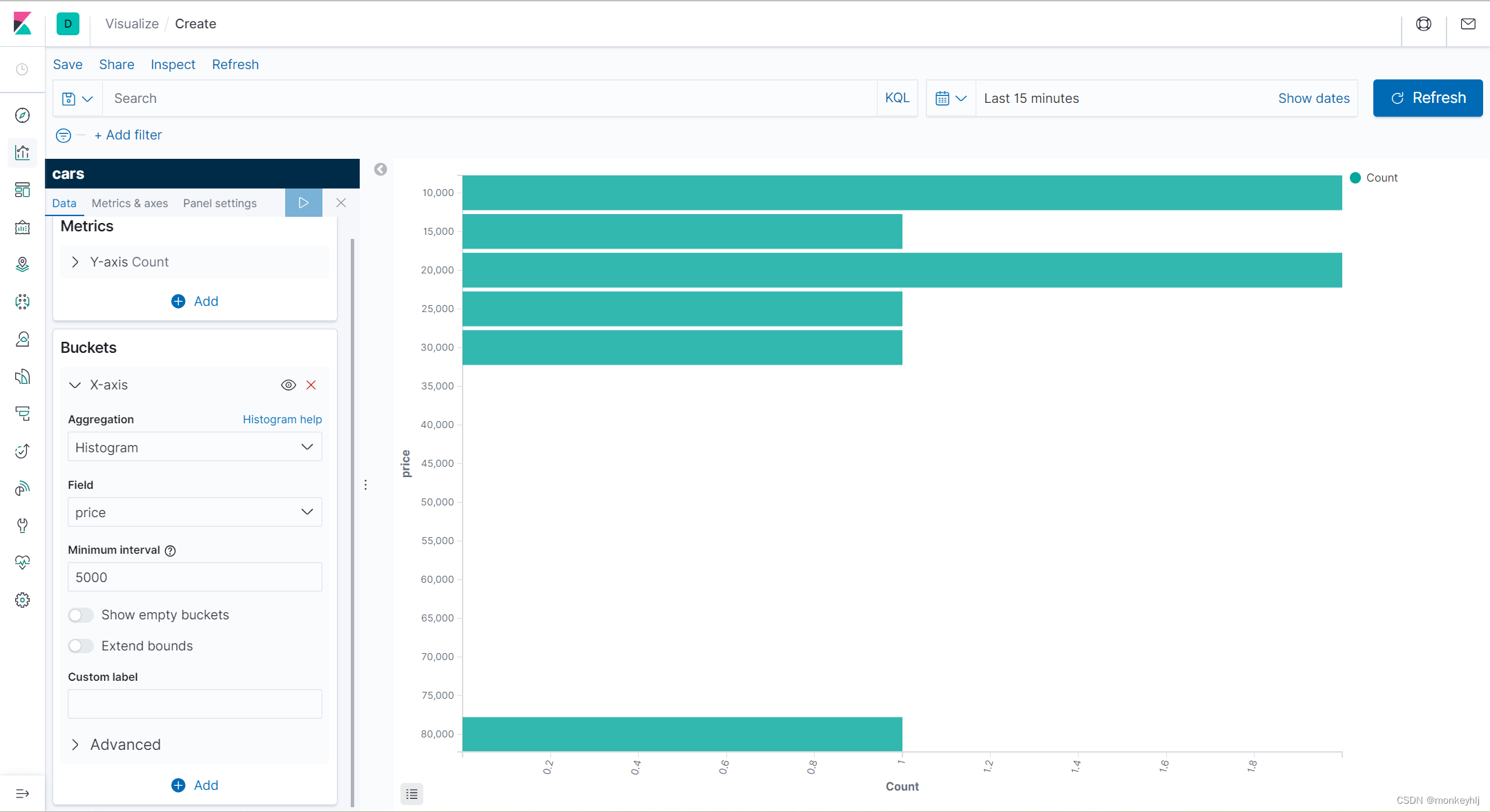
范围分桶Range Aggregation
范围分桶与阶梯分桶类似,也是把数字按照阶段进行分组,只不过range方式需要你自己指定每一组的起始和结束大小
GET /cars/_search
{
"size":0,
"aggs":{
"sold":{
"range": {
"field": "sold",
"ranges" : [
{ "from" : "2014-07-02", "to" : "2014-08-30" }
]
}
}
}
}
结果:
{
"took" : 4,
"timed_out" : false,
"_shards" : {
"total" : 1,
"successful" : 1,
"skipped" : 0,
"failed" : 0
},
"hits" : {
"total" : {
"value" : 8,
"relation" : "eq"
},
"max_score" : null,
"hits" : [ ]
},
"aggregations" : {
"sold" : {
"buckets" : [
{
"key" : "2014-07-02T00:00:00.000Z-2014-08-30T00:00:00.000Z",
"from" : 1.4042592E12,
"from_as_string" : "2014-07-02T00:00:00.000Z",
"to" : 1.4093568E12,
"to_as_string" : "2014-08-30T00:00:00.000Z",
"doc_count" : 2
}
]
}
}
}
【注意】这里差一点跟查时间范围内数据混淆了,查sold时间范围内数据如下:
GET /cars/_search
{
"query": {
"range": {
"sold": {
"gte": "2014-07-01",
"lte": "2014-09-01"
}
}
}
}
结果:
{
"took" : 1,
"timed_out" : false,
"_shards" : {
"total" : 1,
"successful" : 1,
"skipped" : 0,
"failed" : 0
},
"hits" : {
"total" : {
"value" : 2,
"relation" : "eq"
},
"max_score" : 1.0,
"hits" : [
{
"_index" : "cars",
"_type" : "transactions",
"_id" : "JPmhLI0BcVBqhfH0_Xnk",
"_score" : 1.0,
"_source" : {
"price" : 15000,
"color" : "blue",
"make" : "toyota",
"sold" : "2014-07-02"
}
},
{
"_index" : "cars",
"_type" : "transactions",
"_id" : "JfmhLI0BcVBqhfH0_Xnk",
"_score" : 1.0,
"_source" : {
"price" : 12000,
"color" : "green",
"make" : "toyota",
"sold" : "2014-08-19"
}
}
]
}
}
不同语言客户端代码
【文档参考】https://www.elastic.co/guide/en/elasticsearch/client/index.html
【参考】https://zhuanlan.zhihu.com/p/649902671
【参考】https://blog.csdn.net/TinaCSDN/article/details/108290648
【参考】https://blog.csdn.net/mo_sss/article/details/133808562
【参考】https://blog.csdn.net/mijichui2153/article/details/126177041
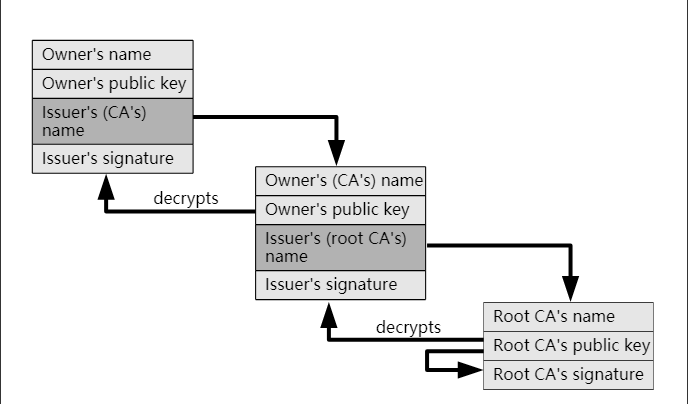





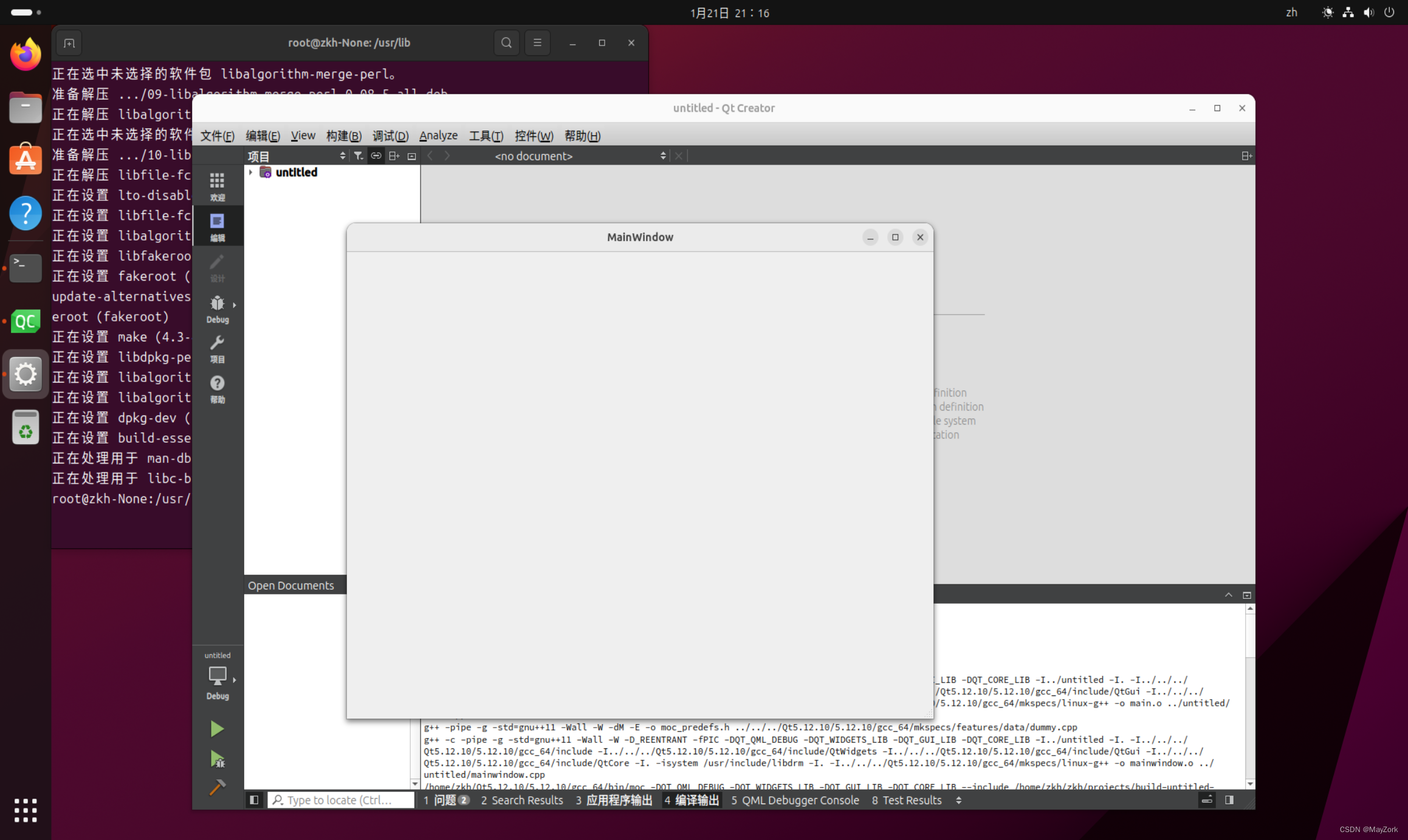


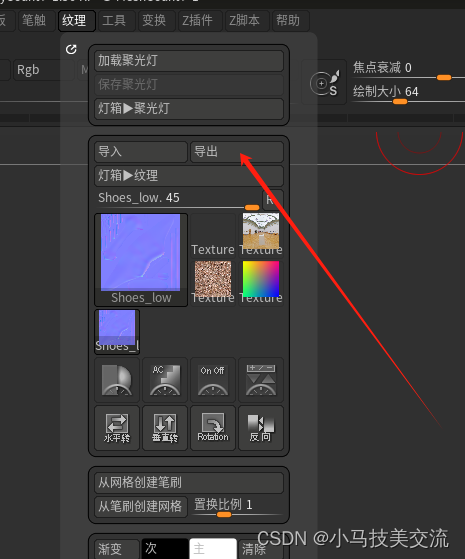
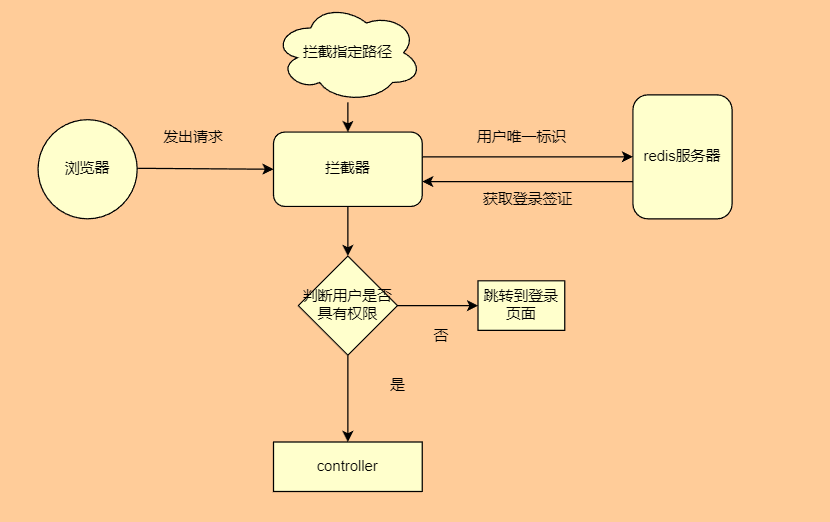
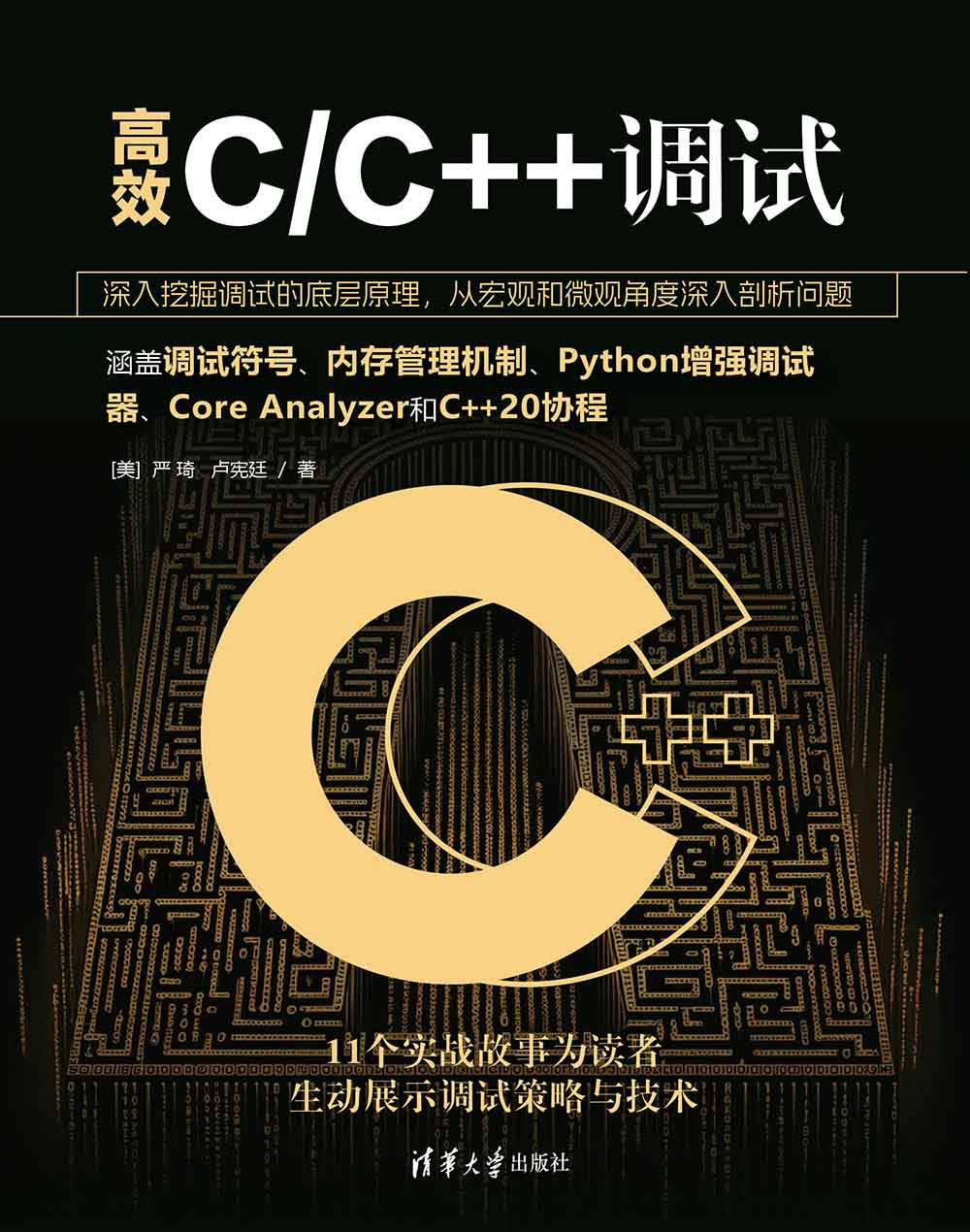
![[计算机提升] Bitlocker驱动器加密与关闭](https://img-blog.csdnimg.cn/direct/5588ee7c65ab410eaf3eab609dc1e681.png)



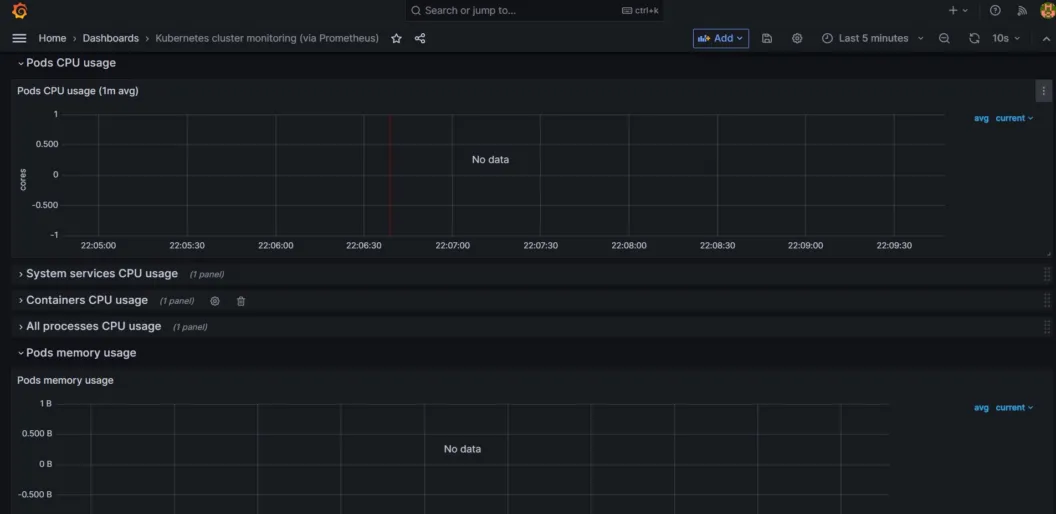

![[C++]:12:模拟实现list](https://img-blog.csdnimg.cn/direct/a9a6d33e8ddb4f74bd7ecfa49b9b61e6.png)